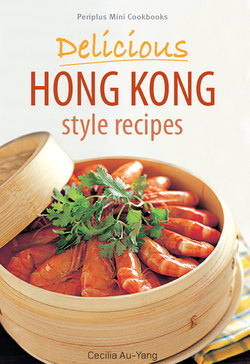Читать книгу Mini Delicious Hong Kong Style Recipes - Cecilia Au-Yang - Страница 5
На сайте Литреса книга снята с продажи.
ОглавлениеBasic Hongkong Ingredients
Bean sprouts are sprouted green mung peas eaten blanched in some salads and soups, or quickly stir-fried as a vegetable. Always wash and trim bean sprouts before using, and pinch off the straggly tails just before use if desired.
Chillies come in many shapes and sizes. The relatively mild large red (ripe) or green (unripe) chillies are commonly used, with tiny bird’s-eye chillies providing much more heat. Chilli oil is also used in some dishes and can be purchased from Chinese supermarkets.
Coriander leaves or cilantro are the leaves of the coriander plant and are often referred to as Chinese parsley. They have a strong flavour and aroma and are typically used as a garnish.
Dried black fungus, also known as wood ear fungus, tree ears or cloud ears, is dull black when dried but becomes shiny black after soaking. Readily available from Chinese stores.
Dried prawns are a popular seasoning in many Cantonese dishes. Choose dried shrimps that are pink in colour and soak in water to soften before use.
Lap cheong, or Chinese sausages, are perfumed with rose-flavoured wine. They are never eaten alone, but cooked with rice or other food.
Oyster sauce is a Cantonese speciality, regular oyster sauce is a very flavoursome soy-based sauce with oyster extract. Vegetarians should look for the vegetarian version which is sometimes sold as ‘mushroom oyster sauce’.
Red dates are also known as Chinese jujube, or hong zao in Mandarin, and are about the size of a round olive. Although Chinese red dates are sour when raw, they are sweet when matured and dried. Red dates are often eaten during Chinese New Year.
Rice is a staple food in Asia. Long-grain jasmine rice is used in the recipes in this book, and is widely available from all supermarkets. Do not use glutinous or basmati rice.
Rice wine is fermented from freshly steamed rice and has a relatively low alcoholic content. Widely used in Asian cooking, it is readily available in bottles. Japanese sake or dry sherry can be used as a substitute.
Sesame oil is extracted from sesame seeds that have been well toasted, producing a dark, dense, highly aromatic oil that can be used for cooking, marinades, sauces and soups, or as a table condiment. Its nutty, smoky flavour has become a hallmark of Chinese cuisine.
Sesame paste is made from ground, roasted sesame seeds and comes in glass jars covered with oil. It is quite hard and needs to be mixed with a little sesame oil or water to make it into a smooth paste. It should not be confused with sweet sesame paste made from black sesame seeds used in some snacks and desserts. If you can’t find it, use Middle Eastern tahini mixed with sesame oil to give it a more pronounced flavour.
Dried tangerine peel can be bought from Chinese medicinal shops or the dried food stalls in Asian markets. However, it is something that anyone can make during the citrus season—the peels of oranges, mandarins, or tangerines can be dried out in a very slow oven or in a dehydrator, or left to dry naturally, then stored airtight. Do not remove the white pith, as it contains bio-flavonoids and is good for you.
Vinegar is used to balance flavours in sauces and to bring out the natural tastes of foods, almost always in conjunction with a bit of sugar; unless the recipe calls for a specific variety of Chinese vinegar, the best choices are rice vinegar or apple cider vinegar; red wine vinegars do not go well with Chinese flavours.
White fungus, also known as white wood ears, has a crunchy texture and a slightly sweet flavour.
Wine is used frequently in Chinese cooking as a tenderizer, to eliminate the rank taste in meat and fish, to blend flavours and to enhance taste. The best wine for Chinese cooking is rice wine. A possible alternative is dry sherry.
Water chestnut is a crunchy brown tuber. Although its skin is difficult to peel, it is well worth using the fresh variety rather than canned water chestnuts. Fresh yam bean is a better substitute for fresh water chestnuts than the canned variety.
Soy sauce is indispensable to Chinese cuisine. It is fermented from soya beans and salt; used in marinades, stir-fry cooking, sauces and dips; low-salt varieties are now available. It is well worth spending a little extra to purchase high-quality soy sauce, because its distinctive flavour permeates Chinese cuisine, and a poor quality soy sauce can ruin the taste of even the best cooked food. Both light and dark soy sauces are used in the recipes in this book.
